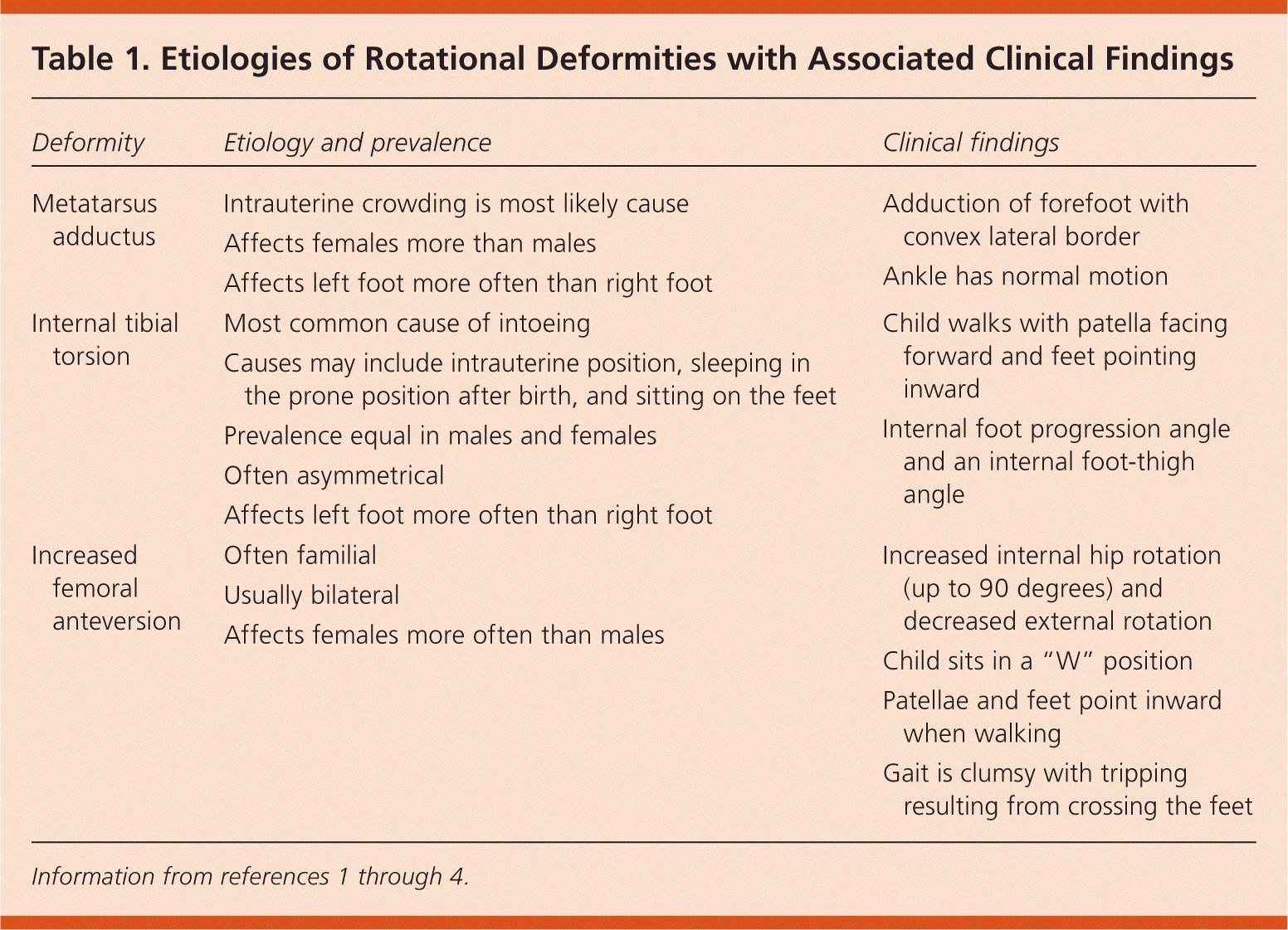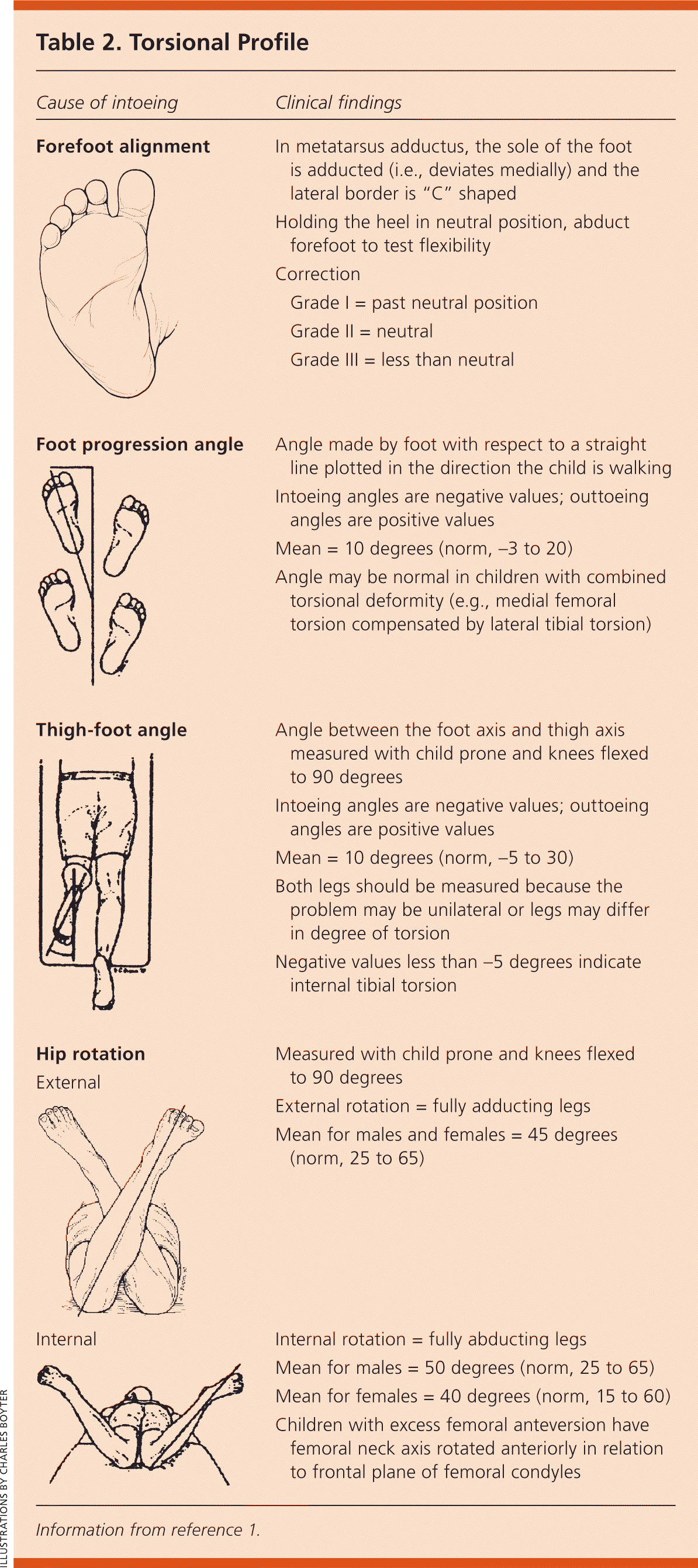
Am Fam Physician. 2011;84(8):937-944
Author disclosure: No relevant financial affiliations to disclose.
Clinical Question
What is the best way to evaluate and manage intoeing in children?
Evidence-Based Answer
Intoeing can be accurately diagnosed using a history, physical examination, and torsional profile. (Strength of Recommendation [SOR]: C, based on expert consensus.) The three most common causes of intoeing (i.e., metatarsus adductus, internal tibial torsion, and increased femoral anteversion) initially should be managed conservatively with serial examinations and reassurance. (SOR: C, based on expert consensus.) Patients with rigid metatarsus adductus should have serial casting if it persists beyond six months of age. (SOR: C, based on expert consensus.) Patients with internal tibial torsion that persists into midchildhood should be referred for surgical correction. (SOR: C, based on expert consensus.) Patients with increased femoral anteversion that persists past eight to 10 years of age should be referred for surgical correction. (SOR: C, based on expert consensus.)
Evidence Summary
The etiology of intoeing (i.e., metatarsus adductus, internal tibial torsion, and increased femoral anteversion) is debated, although the causes generally can be correlated with the patient's age at onset.1,2 An accurate diagnosis can be made with a history and physical examination (Table 11–4 ).5 The history should include the age at onset, associated symptoms (e.g., pain, limping, tripping), seating style, and the main concerns of the patient and parents. Medical history (e.g., birth complications, development, injuries) and family history (e.g., similar conditions in other family members) should be obtained. A torsional profile (Table 21 ) can be performed quickly, and can enhance assessment and prompt referral if needed.1–5

| Deformity | Etiology and prevalence | Clinical findings |
|---|---|---|
| Metatarsus adductus | Intrauterine crowding is most likely cause |
|
| Affects females more than males | ||
| Affects left foot more often than right foot | ||
| Internal tibial torsion | Most common cause of intoeing |
|
| Causes may include intrauterine position, sleeping in the prone position after birth, and sitting on the feet | ||
| Prevalence equal in males and females | ||
| Often asymmetrical | ||
| Affects left foot more often than right foot | ||
| Increased femoral anteversion | Often familial |
|
| Usually bilateral | ||
| Affects females more often than males |

| Cause of intoeing | Clinical findings | |
|---|---|---|
| Forefoot alignment | In metatarsus adductus, the sole of the foot is adducted (i.e., deviates medially) and the lateral border is “C” shaped | |
| Holding the heel in neutral position, abduct forefoot to test flexibility | ||
| Correction | ||
| Grade I = past neutral position | ||
| Grade II = neutral | ||
| Grade III = less than neutral | ||
| Foot progression angle | Angle made by foot with respect to a straight line plotted in the direction the child is walking | |
| Intoeing angles are negative values; outtoeing angles are positive values | ||
| Mean = 10 degrees (norm, –3 to 20) | ||
| Angle may be normal in children with combined torsional deformity (e.g., medial femoral torsion compensated by lateral tibial torsion) | ||
| Thigh-foot angle | Angle between the foot axis and thigh axis measured with child prone and knees flexed to 90 degrees | |
| Intoeing angles are negative values; outtoeing angles are positive values | ||
| Mean = 10 degrees (norm, –5 to 30) | ||
| Both legs should be measured because the problem may be unilateral or legs may differ in degree of torsion | ||
| Negative values less than –5 degrees indicate internal tibial torsion | ||
| Hip rotation External | Measured with child prone and knees flexed to 90 degrees | |
| External rotation = fully adducting legs | ||
| Mean for males and females = 45 degrees (norm, 25 to 65) | ||
| Internal | Internal rotation = fully abducting legs | |
| Mean for males = 50 degrees (norm, 25 to 65) | ||
| Mean for females = 40 degrees (norm, 15 to 60) | ||
| Children with excess femoral anteversion have femoral neck axis rotated anteriorly in relation to frontal plane of femoral condyles | ||
Metatarsus adductus occurs in one in 1,000 live births.6 Grades I and II can be observed for resolution by 12 months of age.7 Grade III is commonly treated with six weeks of serial casting.7 Studies have found that only patients with metatarsus adductus showed a benefit with casting, and the condition usually corrects itself without treatment within the first year of life.2,4
Internal tibial torsion usually is noticed after a child begins to walk. It gradually resolves on its own by eight years of age in more than 95 percent of patients.2,4 Residual deformities have not been shown to affect running, jumping, or risk of future arthritis.7,8 However, if the deformity persists into skeletal maturity and causes functional problems, a tibia derotation osteotomy may be performed to improve alignment.1,2
Increased femoral anteversion describes the normal position of the femur, which is medially rotated on its long axis at birth. Braces or shoe modifications typically are not helpful.6 Femoral anteversion is a benign condition with spontaneous resolution by late childhood in more than 80 percent of patients.1,2 Surgical correction can be associated with significant complications.1,2,4 Conditions that may warrant a surgical approach include persistence after eight years of age, severe deformity causing considerable cosmetic and functional disability, anteversion in excess of 50 degrees, and deformity more than three standard deviations above the mean.1
Recommendations from Others
No standard guidelines or recommendations on the treatment of intoeing have been accepted. Expert consensus continues to advise that torsional problems follow a benign and predictable course, with most cases resolving without intervention.1,5 Conservative treatment and reassurance continue to be the recommended initial responses to intoeing in children, whereas the use of special shoes, casts, or braces is not empirically supported. Surgery is reserved for older children with pronounced deformities.5
Several studies agree with expert consensus that physicians should talk with parents about the risks and benefits of treatment in children with a torsional deformity.1,2,4,9 Two systematic reviews confirm that derotation osteotomies of the femur and tibia are effective but are associated with statistically significant complication rates.2,9
